avicenna ibn sina (47 Ergebnisse)
Produktart
- Alle Produktarten
- Bücher (46)
- Magazine & Zeitschriften
- Comics
- Noten
- Kunst, Grafik & Poster
- Fotografien
- Karten
-
Manuskripte &
Papierantiquitäten (1)
Zustand
- Alle
- Neu
- Antiquarisch/Gebraucht
Einband
Weitere Eigenschaften
Gratisversand
Land des Verkäufers
Verkäuferbewertung
-
Urguza fi 't-tibb (Lehrgedicht zur Medizin). Neudruck nach der Handschrift MS Orient. A 2032 der Forschungsbibliothek Gotha. Mit einem Geleitwort von Burchhard Brentjes, einem französischen Vorwort von Mohammed Allal Sinaceur und einer Einführung von Sonja Brentjes und Sami Chalhoub.
Verlag: Leipzig, Zentralantiquariat der Deutschen Demokratischen Republik., 1980
Anbieter: Antiquariat im Hufelandhaus GmbH vormals Lange & Springer, Berlin, Deutschland
17 S. (einleitender Text), 43 nicht num. Bll. mit der einfarbigen Wiedergabe der Originalhandschrift. Ill. Original-Pappband. Äußerst gut erhalten. Der Neudruck erfolgte mit Unterstützung der UNESCO-Kommission der Deutschen Demokratischen Republik. Sprache: Deutsch.
-
Urguza fi't-tibb (Lehrgedicht zur Medizin). Neudruck nach der Handschrift MS Orient. A 2032 der Forschungsbibliothek Gotha. Mit einem Geleitwort von Burchhard Brentjes, einem französischen Vorwort von Mohammed Allal Sinaceur und einer Einführung von Sonja Brentjes und Sami Chalhoub.
Verlag: Leipzig, Zentralantiquariat, 1980., 1980
Anbieter: Antiquariat Carl Wegner, Berlin, B, Deutschland
Verbandsmitglied: GIAQ
Hardcover. Kl.-8°. Bedruckter Original-Pappband. 17 (+1) Seiten einleitende Texte und 86 nicht paginierte Seiten mit den einfarbigen(!) Wiedergaben der farbigen Originalhandschrift. Seite für Seite überprüft. Sauberes, wohlerhaltenes Exemplar ohne Einträge, fest im Block. -- Bitte Portokosten außerhalb EU erfragen! / Please ask for postage costs outside EU! / S ' il vous plait demander des frais de port en dehors de l ' UE! -- Herzlichen Dank für Ihre Bestellung! MusiVit3.
-
Metaphysica sive Prima Philosophia (Venise, 1495). Réimpression en fac-similé agrandi. Avec une clé des abréviations
Verlag: Louvain, Edition de la bibliothèque S.J. , 1961., 1961
Anbieter: Antiquariat FOLIO Karpinski u. Gaukesbrink GbR, Münster, Deutschland
Folio. 42 Bll. Originalleder (Hardcover). Hochwertiger stabiler Ledereinband in sehr gutem Zustand (lediglich die unteren Ecken leicht bestoßen). Innen sehr sauber. Sprache: la.
-
Opera philosophica. Venise, 1508. Reimpression en fac-simile agrandi avec un tableau des abreviations
Verlag: Edition de la bibliotheque S. J
Anbieter: Powell's Bookstores Chicago, ABAA, Chicago, IL, USA
Zustand: Used - Good. 1961. Cloth, folio, 117 leaves. Corners bumped. Joints cracked on outside of binding, but still holding well. Facsimile of 1508 edition.
-
Opera philosophica Venise, 1508. Réimpression en fac-similé agrandi. Avec un tableau des abréviations
Verlag: Louvain, Edition de la bibliothèque S.J. , 1961., 1961
Anbieter: Antiquariat FOLIO Karpinski u. Gaukesbrink GbR, Münster, Deutschland
Folio. 118 Bll. Ledereinband (Hardcover). Hochwertiger stabiler Ledereinband in sehr gutem Zustand (lediglich die unteren Ecken leicht bestoßen). Innen sehr sauber. Sprache: la.
-
Ibn Sina (Avicenna) Psychologie V Jeho Dile As-Sifa'. Vydat par Jan Bakos
Verlag: Praha: Nakladatelstvi Ceskoslovenske Akademie Ved, 1956
Anbieter: Bow Windows Bookshop (ABA, ILAB), Lewes, Vereinigtes Königreich
8vo. (276) pp. A fine bespoke binding of tan full morocco with a fold-over flap in the Middle Eastern style, elaborate gilt corner pieces with a matching circular roundel to the upper cover, a central leaved rosette with inlaid green and red morocco panels and gilt tooling, a pared down version of the same design appears on the rear cover, marbled endpapers. Slight wear to the green leather on the upper cover, else a lovely copy of what is almost certainly a unique binding. The first volume only of bilingual edition of the work featuring the Arab text, the French translation would be in the other volume not present here.
-
Avicennae summi inter Arabes medici Fen I lib. I canonis. In usum Gymnasii Patavini, Editio correctior.
Verlag: Padua, Paolo Frambotti, 1636., 1636
Anbieter: Antiquariat INLIBRIS Gilhofer Nfg. GmbH, Vienna, A, Österreich
12mo. 140, (2) pp., final blank leaf. - (Bound with) II: Hippocrates. Aphorismorum sectiones VII. Nicolao Leoniceno Vicentino interprete. Accessit octava ex Ant. Musae Brasavoli commentariis. Ibid., 1649. (36), 111, (1) pp. - (Bound with) III: Galenus. Ars medicinalis. Nicolao Leoniceno interprete. Ibid., 1642. (12), 173, (1) pp., final blank leaf. Contemporary limp vellum. A fine Padovan 17th century manual assembling the great ancient and medieval medical works, published separately, in a single handy volume. From the Middle Ages to the Renaissance and beyond, the compulsory teaching matter of Avicenna's monumental "Qanun" always included the part on physiology in the first fen of book 1, which expounds the general principles of medicine. The present edition is bound with the principal works of Hippocrates and Galen, both edited by the Italian physician and humanist Niccolò Leoniceno (1428-1524). - Some browning and brownstaining. 18th century annotations to flyleaf; ownership of Antonio Barduni (?) to front pastedown. An appealing pocket-sized set containing in a nutshell the staples of the old medical schools from which European medical training was in the process of breaking free. - Cf. Krivatsy 499, 4508. Not in Wellcome.
-
Flores Avicenne.
Verlag: (Lyon, Claude Davost for Barthélemy Trot, 14 Aug. 1508)., 1508
Anbieter: Antiquariat INLIBRIS Gilhofer Nfg. GmbH, Vienna, A, Österreich
Erstausgabe
8vo. (2), CLXVI ff. With several botanical woodcut initials. Contemporary dark goatskin, blind-tooled in a panel design. First edition of this important capsule edition of Ibn Sina's comprehensive Canon of Medicine (Kitab al-Qanun fi al-tibb). Designed with the Western medical student and practicioner in mind, Michael de Capella's abridgement of the greatest and most influential work in medieval and early modern medical history is here pared down to a nutshell manual of 166 leaves. "The preface refers to the importance in medicine of aphoristic works that can readily be committed to memory and to the example of Hippocratic writings. The task of abbreviation was undertaken with such enthusiasm that Avicenna's chapter on the elements (Canon 1:1:2) [.] was compressed from about 550 words in the full Gerard of Cremona version into 53 in the 'Flores'. This compendium was twice reissued, in 1514 and again in 1528" (Siraisi). - Provenance: 1) Title-page shows handwritten ownership of the Augustinian monastery of Zaragoza, Spain, dated 1743. 2) 20th century bookplate of Karl and Thilde Wagner to front pastedown. - Binding somewhat worn, spine-ends and extremeties chipped. Some browning throughout, inkstains on title-page and a couple of minor stains in text. A good copy. - Adams A 2319. Durling 411. USTC 143378. N. G. Siraisi, "The Changing Fortunes of a Traditional Text", in The Medical Renaissance of the Sixteenth Century (1985), p. 21. Cf. BM-STC French 234 (1514 ed. only). Cf. Wellcome I, 577 (1528 ed. only).
-
Al-Ilahiyat min al-Shifa' [The Metaphysics from the Book of Healing].
Verlag: Mashhad, Persia, [1642/43 CE =] 1052 H., 1642
Anbieter: Antiquariat INLIBRIS Gilhofer Nfg. GmbH, Vienna, A, Österreich
Tall 8vo (136 x 258 mm). Arabic manuscript on unsophisticated oriental paper. 206 leaves. 20 lines, black and occasional red ink with underlinings in red. Restored red morocco oriental binding with blind-tooled medaillons to both covers, using oder material from a shorter binding. The fourth and final part of Ibn Sina's famous "Kitab Al-Shifa'" ("The Book of Healing"), a great scientific and philosophical encyclopedia that covers logic, natural sciences, mathematics including astronomy, and, as here, metaphysics and religion. - Browned throughout with occasional waterstaining. Early waqf stamp near the colophon. In all a good manuscript, copied in Safavid Persia by Shafi' Muhammad bin Muhammad al-Qayni. - GAL I, 454, 18.
-
Al-Urjuza fi l-tibb [Poem on Medicine] and other medical and alchemical treatises.
Verlag: [Probably Ottoman Empire, ca. 1690s / late 17th century CE]., 1690
Anbieter: Antiquariat INLIBRIS Gilhofer Nfg. GmbH, Vienna, A, Österreich
4to (ca. 160 x 216 mm). Arabic manuscript on polished paper. 8 parts. 93 leaves, final blank leaf. Written in black ink throughout with red chapter headings, 19 lines, two columns and single column. Contemporary brown leather binding with gilt borders and recessed and gilt central ornament, stamped in relief. A fine, complete composite medical manuscript, including pharmacological and alchemical material. The principal section is formed by the "Urjuza fi l-tibb", or "Medical Poem" of Ibn Sina, which can be considered a poetic summary in 1326 verses of the author's great encyclopedic textbook, the Qanun. The verse form made it popular as a mnemonic in the process of transmitting the Canon's medical knowledge from master to student. The second part of the work is more directly concerned with anatomical matters, but also discusses the pulse and urine. - The following section is "Al-Maqala al-Aminiya fi 'l-fasd", a treatise in ten chapters on phlebotomy. It was written by Abul-Hasan Hibatallah ibn Said ibn al-Tilmidi (d. 1165 CE), the Christian physician to the Abbasid caliph Al-Muqtafi, hailed as one of the greatest medical men of his age. - A subsequent essay treats the refinement of chemical substances by burning and washing, also discussing the characteristics of the combustion of various metals, including gold, silver, steel, copper, and lead. Further parts concern the refinement of medicines (by Al-Hasan ibn Bahram al-Mutatabbib) and the treatment of poisonings in general, but also offering an alphabetical pharmacopoeia. - Leather covers professionally restored; modern marbled pastedowns. Internally quite clean; a few leaves show edge tears but without loss to text. Altogether a fine Arabic medical manuscript comprising a wide range of relevant material. - GAL I, 457, 81 ("Manzuma fi 't-tibb"); GAL S I, 823. For al-Maqala al-Aminiya see GAL I, 487.
-
Opera. Auicene perhypatetici philosophi ac medicorum facile primi opera in luce redacta
Verlag: Minerva GmbH, 1961
Buch
29,5 x 21,5 cm. Zustand: Gut. Unveränderter Nachdruck. Ac nuper quantum ars niti potuit per canonicos emendata. Logyca. Sufficientia. De celo et mundo. De anima. De animalibus. De intelligentiis, Alpharabius de intelligentiis, Philosophia prima. - Innen sauberer, guter Zustand. Hardcover, Pappeinband (mit Kunststoffbezug), mit den üblichen Bibliotheks-Markierungen, Stempeln und Einträgen, innen wie außen, siehe Bilder. MIG-27-03B|A99 la Gewicht in Gramm: 1040.
-
Lukman hekimin merhemleri: Tebipçilik ilminin kanunlari (U. I. Karimovic ve P. G. Bulgakovich taiyarlan ikinci nesirinden tercüme). Translated from Russian by Annagiliç Esenov.
Verlag: Ruh, Ashgabat, 1992
Anbieter: Khalkedon Rare Books, IOBA, Istanbul, Türkei
Buch
Soft cover. Zustand: Fine. Paperback. Cr. 8vo. (20 x 14 cm). In Turkmen. 35, [4] p. Lukman hekimin merhemleri: Tebipçilik ilminin kanunlari (U. I. Karimovic ve P. G. Bulgakovich taiyarlan ikinci nesirinden tercüme). Translated from Russian by Annagiliç Esenov.
-
Introduction a Avicenne. Son epître des définitions. Traduction avec notes. Préface de Miguel Asin Palacios.
Anbieter: Antiquariaat Isis, Groningen, Niederlande
Paris, Brouwer, 1933. (XXXVIII) 217 pp. Sewn. (BFP, 3) *owner's name, endpapers and text foxed, otherwise in good condition* With signature of B. Delfgaauw.
-
La distinction de l'essence et de l'existence d'après Ibn Sina (Avicenne).
Anbieter: Antiquariaat Isis, Groningen, Niederlande
Paris, De Brouwer, 1937. (XVI) 546 pp. Sewn. Bibliography. *spine waterstained and slightly damaged at the bottom, covers and spine discoloured, owner's name, otherwise in good condition*.
-
De febribus [.] in Avic[ennae] quarti canonis fen primam. Dilucida atque optima expositio [.].
Verlag: Venice, heirs of Lucantonio Giunta, 1560., 1560
Anbieter: Antiquariat INLIBRIS Gilhofer Nfg. GmbH, Vienna, A, Österreich
Folio (227 x 317 mm). (18), 191 ff. (without final blank). Printer's device on title page and, in a different version, on the last page. Contemporary vellum. Traces of ties. First issue under this title, previously released as "Expositio in primam fen quarti canonis Avicennae" (1506). A commentary (with the text, in the version of Gerardus Cremonensis) of book four, part (fen) one of Avicenna's systematic "Canon of Medicine", written in Arabic but widely translated throughout the Middle Ages and the basis of medical training in the West as late as the mid-17th century. It continues in use to this day in parts of the Arab world. Through this encyclopedic work, the author exerted "perhaps a wider influence in the eastern and western hemispheres than any other Islamic thinker" (PMM). "The 'Qanun' [.] contains some of the most illuminating thoughts pertaining to distinction of mediastinitis from pleurisy; contagious nature of phthisis; distribution of diseases by water and soil; careful description of skin troubles; of sexual diseases and perversions; of nervous ailments" (Sarton, Introduction to the History of Science). The present part is dedicated to a discussion of feverish illnesses. - 17th century ownership "Bernardinus Statius Phys." on flyleaf. Some brownstaining throughout, as common; some worming to spine. Still a good copy. - Edit 16, CNCE 2345. Adams A 1541. Durling 245. Cf. Wellcome I, 387 (only the Venice reprint). PMM 11.
-
De febribus [.] in Avic[ennae] quarti canonis fen primam. Dilucida atque optima expositio [.].
Verlag: Venice, heirs of Lucantonio Giunta, 1560., 1560
Anbieter: Antiquariat INLIBRIS Gilhofer Nfg. GmbH, Vienna, A, Österreich
Folio (240 x 354 mm). (18), 191 ff. (without final blank). Printer's device on title page and, in a different version, on the last page. Contemporary cardboard binding with marbled spine and ms. label. Stored in custom-made cloth-and-paper slipcase. First issue under this title, previously released as "Expositio in primam fen quarti canonis Avicennae" (1506). A commentary (with the text, in the version of Gerardus Cremonensis) of book four, part (fen) one of Avicenna's systematic "Canon of Medicine", written in Arabic but widely translated throughout the Middle Ages and the basis of medical training in the West as late as the mid-17th century. It continues in use to this day in parts of the Arab world. Through this encyclopedic work, the author exerted "perhaps a wider influence in the eastern and western hemispheres than any other Islamic thinker" (PMM). "The 'Qanun' [.] contains some of the most illuminating thoughts pertaining to distinction of mediastinitis from pleurisy; contagious nature of phthisis; distribution of diseases by water and soil; careful description of skin troubles; of sexual diseases and perversions; of nervous ailments" (Sarton, Introduction to the History of Science). The present part is dedicated to a discussion of feverish illnesses. - 18th century ownership "Manhem" on title page. Some brownstaining throughout, as common; some waterstains near end; occasional inkstains and marginal annotations. An untrimmed, comparatively wide-margined copy. - Edit 16, CNCE 2345. Adams A 1541. Durling 245. Cf. Wellcome I, 387 (only the Venice reprint). PMM 11.
-
Zur Psychologie und Psychotherapie Ibn Sinas.
Verlag: Glienicke/Berlin, Cambridge/Mass. Galda und Wilch 1999, 1999
ISBN 10: 393139722XISBN 13: 9783931397227
Anbieter: Antiquariat Carl Wegner, Berlin, B, Deutschland
Verbandsmitglied: GIAQ
Buch Erstausgabe
Hardcover. 8°, Original-Leder im originalen Schutzumschlag. IV, 197 Seiten. Die ersten Seiten mit winzigem Fleck am Rand, ansonsten schön sauber und in gutem Zustand. -- Bitte Portokosten außerhalb EU erfragen! / Please ask for postage costs outside EU! / S ' il vous plait demander des frais de port en dehors de l ' UE! -- Herzlichen Dank für Ihre Bestellung! Arab.ik.
-
Avicenna and the Aristotelian tradition. Introduction to reading Avicenna' s philosophical works ( = Islamic philosophy anf theology, texts and studies, vol. IV ).
Verlag: Leiden u. a. E. J. Brill, 1988., 1988
ISBN 10: 9004085009ISBN 13: 9789004085008
Anbieter: Antiquariat Carl Wegner, Berlin, B, Deutschland
Verbandsmitglied: GIAQ
Buch Erstausgabe
Hardcover. 8°, Original blue cloth with gold embossed cover titles. XII (+I), 341 (1) pages. Our copy comes from the estate of Dr. Rainer Nabielek (born July 11, 1944 in Neutitschein - 10/2021), medical historian, sexologist and orientalist. With his ownership stamp on the flyleaf. Otherwise very clean and in good condition. --- Blaues Original-Leinen mit goldgeprägten Einbandtiteln. XII (+I), 341 (1) Seiten. Unser Exemplar stammt aus dem Nachlass von Dr. Rainer Nabielek (* 11. Juli 1944 in Neutitschein - 10/2021), Medizinhistoriker, Sexualwissenschaftler und Orientalist. Mit seinem Besitzstempel auf dem Vorsatz. Ansonsten sehr schön sauber und in gutem Zustand. -- Bitte Portokosten außerhalb EU erfragen! / Please ask for postage costs outside EU! / S ' il vous plait demander des frais de port en dehors de l ' UE! -- Herzlichen Dank für Ihre Bestellung! Arab.ik.
-
La distinction de l?essence et de l?existence d?après Ibn Sina (Avicenne)
Verlag: Paris, Desclée de Brouwer , 1937., 1937
Anbieter: Antiquariat FOLIO Karpinski u. Gaukesbrink GbR, Münster, Deutschland
16,546 S. Originalbroschur (Softcover). Einband mit Lichtrand, das hintere Gelenk stabilisiert, die Lagen sind geöffnet, aber nicht beschnitten. Text sauber, guter Zustand. Sprache: fr.
-
In primam totam Fen primi libri canonis Avicenn[a]e dilucidissima & expectatissima expositio. Nunc primum in lucem edita, illustrata, & completa aßiduo labore, & longo studio Marci Oddi Medici eiusdem filij.
Verlag: Venice, Paolo and Antonio Meietti, 1575., 1575
Anbieter: Antiquariat INLIBRIS Gilhofer Nfg. GmbH, Vienna, A, Österreich
4to. With woodcut device on title-page. Contemporary limp vellum. Rare first and only edition of a commentary on book I, fen I of Avicenna's Canon, including the Latin version of the text by Andrea Alpago and Jacob Mantino. Like most of Oddi's work it was published posthumously by his son Marco degli Oddi. "Although in the body of his work much of the time he treated Avicenna with nominal respect, this was apt to be achieved through a procedure of deducing Avicenna's 'real' opinion by consulting Galen. In addition, Oddo Oddi had a long-standing interest in the problem of securing a better Latin text of the Canon (he was on the academic committee that approved Alpago's work and he encouraged Graziolo many years later); he based his exposition on Alpago's text, which he claimed to be in general use, and rather frequently compared the latter's renderings with those of Gerard of Cremona and Jakob Mantino." (Siraisi). Before practicing Medicine in Venice, Oddo degli Oddi (1478-1558) taught classics (Greek and Latin) at the University of Padua. Eventually he went back to Padua, where he taught Medicine. He was a committed supporter of Galen's doctrines. - With owner's inscription on fly-leaf dated 1586, two owner's names on title-page (one struck trough) and some manuscript notes in the margins. Binding slightly wrinkled, but internally in very good condition. - Arcadian library 15358. Durling 3388. Edit 16, 30889. USTC 845237 (4 copies outside Italy). Cf. N. G. Siraisi, Avicenna in Renaissance Italy: The Canon and medical teaching in Italian universities after 1500 (1987), p. 193.
-
In IIII. fen primi canonis Avic. commentarius doctissimus, nunc primum in lucem editus impressus anno LX sed hucusque (immerito) incognitus.
Verlag: Bologna, Giovanni Rossi, 1591., 1591
Anbieter: Antiquariat INLIBRIS Gilhofer Nfg. GmbH, Vienna, A, Österreich
Erstausgabe
Folio (301 x 220 mm). (14 [including final blank]), 320 ff. (without the two final leaves cited by Edit 16 but not required by Durling). Title printed in red and black with woodcut device. Modern full vellum on 3 raised bands. Well-produced reissue of the 1560 first edition of this commentary to the 4th Fen of Book 1 of Avicenna's "Qanun", by the Bologna professor of logics and medicine, A. M. Betti (1480-1562). This part, the text of which is provided in full, is dedicated to general therapy, a staple of the compulsory teaching matter at medieval and Renaissance medical schools, if not one of the chapters most frequently to engender extensive published commentaries. Indeed, Avicenna's systematic "Canon of Medicine", written in Arabic but widely translated throughout the Middle Ages, remained the basis of medical training in the West until the latter half of the 16th century, when it gradually began to fall out of the syllabus at most European universities, not disappearing entirely until the mid-17th century. It continues in use to this day in parts of the Arab world. Through this encyclopedic work, the author exerted "perhaps a wider influence in the eastern and western hemispheres than any other Islamic thinker" (PMM). - A single edge flaw to fol. 263 (remargined by an earlier owner). A good, wide-margined copy showing minimal browning, rebound in contemporary style. - Edit 16, CNCE 5658. Durling 401. Adams B 844. Not in BM-STC Italian or Wellcome.
-
Avicennae quarta fen primi libri de universali ratione medendi. Nunc primum M. Iacob Mantini medici hebrei opera Latinate donata.
Verlag: (Venice, Lucantonio Giunta, 8 April 1530)., 1530
Anbieter: Antiquariat INLIBRIS Gilhofer Nfg. GmbH, Vienna, A, Österreich
Erstausgabe
8vo. 60 ff. With Giunta's device on the title-page (a Florentine lily with the L. A. initials). Later vellum with more recent end leaves. First edition of Jacob Mantino's translation into Latin of the fourth part of the first book of Ibn Sina's Canon of Medicine (original title: al-Qanun fi at-Tibb), divided into 31 chapters. Mantino dedicated it to the Doge of the Venetian Republic, Andrea Gritti (1455-1538). - Jacob Mantino (1490-1549) was a Jewish doctor, rabbi and philosopher. He was born in Spain, but he, his family and the Jewish community in Tortosa were forced to flee after refusing Catholic baptism, as decreed by King Ferdinand II and Queen Isabella I of Spain. Mantino grew up in Italy and studied philosophy and medicine at the universities of Bologna and Padua. Most of his adult life was spent being a doctor to the pope and other prominent members of society like cardinals, bishops and ambassadors in Bologna, Verona, Venice and Rome. He was also involved in the (religious) controversy over Henry VIII's divorce from Catharine of Aragon. In 1549, just before his death, he moved to Damascus as ambassador of Venice. Mantino's intellectual production focused on the translation of scientific works from Hebrew and Arabic into Latin, especially medical and philosophical treatises by leading authors of the medieval period, including Moses ben Maimon (Maimonides), Ibn Rushd (Averroes), and Ibn Sina (Avicenna). - Abu 'Ali al-Husayn Ibn Sina (also known by his Latinized name Avicenna, 980-1037) was one of the most prominent intellectuals of the medieval period and of the Islamic Golden Age. He was a Persian polymath; he wrote works on an incredible wide variety of subjects, including philosophy, medicine, astronomy, geography, psychology, Islamic theology, physics, and even poetry. Ibn Sina is mainly known for his medical encyclopaedia The Canon of Medicine, which became a standard medical text for medical students until the late 17th century. - The present work was printed by one of the most successful and important late 15th and early 16th century Italian publishers, Lucantonio Giunta (1457-1538). He was originally from Florence, but was active in Venice from 1489. He was a member of the Giunta family of printers, publishers and booksellers, who were active throughout Europe. - With owner's inscriptions on the front and back paste-downs and on the title-page, and some marginal annotations in brown ink. The paste-downs are partially covered by the newer, slightly foxed, end leaves. The binding is somewhat stained, light water staining to the first half of the work, small restored tears in the outer margin of leaves d1 and d2 without affecting the text. Otherwise in good condition. - Durling 397. Edit 16, CNCE 3543. USTC 811590.
-
[Kitab al-Najah - French]. La logique du fils de Sina, communément appellé Avicenne, prince des philosophes et médecins Arabes.
Verlag: Paris, Vattier, Augustin Courbe & Jean Huart, 1658., 1658
Anbieter: Antiquariat INLIBRIS Gilhofer Nfg. GmbH, Vienna, A, Österreich
Erstausgabe
8vo (120 x 180 mm). (40), 303, (31) pp. Contemporary full red morocco, both covers, spine and leading edges finely gilt. Marbled endpapers. First French edition of the Kitab al-Najah ("The Book of Salvation"), the part on logics from Ibn Sina's great scientific and philosophical encyclopedia Kitab Al-Shifa' ("The Book of Healing"). Translated by the French oriental scholar Pierre Vattier (1623-67), himself a physician like Avicenna. - Ibn Sina's system of logic is known as "Avicennian logic", in contrast to Aristotelian logic. By the 12th century, Avicennian logic had replaced Aristotelian logic as the dominant system in the Islamic world; after the Latin translations of the 12th century, his writings were also an important influence on Western medieval writers such as Albertus Magnus. - Light browning throughout; occasional faint waterstains to the lower margin. Very prettily gilt morocco binding; tools attributable to the binders of Macé-Ruette (cf. Esmerian, La reliure au XVIIe siècle). From the library of the French neurologist Maurice Villaret (1877-1946) with his memento-mori style bookplate to front pastedown. - OCLC 978575366. Cf. GAL I, 454, 18.
-
In primi lib. canonis Avicenna primam fen, profundissima commentaria. Adiecto nuper secundo, quod numquam antea fuerat typis excusum; de membris capite.
Verlag: Venice, Vincenzo Valgrisi & Baldassarre Costantini, 1558., 1558
Anbieter: Antiquariat INLIBRIS Gilhofer Nfg. GmbH, Vienna, A, Österreich
8vo. (32), 651, (1) pp. Contemporary half vellum over pigskin with handwritten spine title and shelfmark. Second posthumous edition (by Giano Matteo Durastante) of the extensive commentary on book (kitab) 1, part (fen) 1 of Avicenna's systematic "Canon of Medicine" by one of the leading Renaissance humanist physicians of Italy, Giambattista da Monte (1498-1551), first published in 1557. A corrected and enlarged edition of the work previously edited by W. Lublin and published in Venice in 1554. "The newly added chapter De membris (p. 553-605) is followed by 2 others: De facultatibus and De virtutibus naturalibus ministrantibus" (Durling). - Avicenna's Arabic "Qanun" was widely translated throughout the Middle Ages and remained the basis of medical training in the West as late as the mid-17th century. It continues in use to this day in parts of the Arab world. Through this encyclopedic work, the author exerted "perhaps a wider influence in the eastern and western hemispheres than any other Islamic thinker" (PMM). "The 'Qanun' [.] contains some of the most illuminating thoughts pertaining to distinction of mediastinitis from pleurisy; contagious nature of phthisis; distribution of diseases by water and soil; careful description of skin troubles; of sexual diseases and perversions; of nervous ailments" (Sarton, Introduction to the History of Science). The present part offers a definition of medicine and is mainly dedicated to a discussion of the four humours and temperaments. - Binding slightly wormed; vellum somewhat creased. Paper occasionally wormed and waterstained. - Edit 16, CNCE 15945. Wellcome I, 4428. OCLC 1157690416. Cf. Durling 3273, Adams M 1681 (1557 ed.), PMM 11. Not in BM-STC Italian, Osler, Waller, or Garrison/M.
-
Avicennae quarta fen primi libri de universali ratione medendi: nunc primum. m. Iacob Mantini medici hebrei: opera Latinate donata.(colophon:) Venice, Lucantonio Giunti, 8 April 1530. 8vo. With Giunti's printer's device on the title page (a Florentine lily with the L. A. initials). Later vellum with more recent end leaves.
Anbieter: Antiquariaat FORUM BV, Houten, Niederlande
Erstausgabe
60 ll.First edition of Jacob Mantino's translation into Latin of the fourth part of the first book of Ibn Sina's Canon of Medicine (original title: al-Qanun fi at-Tibb), divided into 31 chapters. Mantino dedicated it to the Doge of the Venetian Republic, Andrea Gritti (1455-1538).Jacob Mantino (1490-1549) was a Jewish doctor, rabbi and philosopher. He was born in Spain, but he, his family and the Jewish community in Tortosa were forced to flee after refusing catholic baptism, as decreed by the catholic King Ferdinand II and Queen Isabella I of Spain. Mantino grew up in Italy and studied philosophy and medicine at the universities of Bologna and Padua. Most of his adult life was spent being a doctor to the pope and other prominent members of society like cardinals, bishops and ambassadors in Bologna, Verona, Venice and Rome. He was also involved in the (religious) controversy over Henry VIII's divorce from Catharine of Aragon. In 1549, just before his death, he moved to Damascus as ambassador of Venice. Mantino's intellectual production focused on the translation of scientific works from Hebrew and Arabic into Latin, especially medical and philosophical treatises by leading authors of the medieval period, including Moses ben Maimon (Maimonides), Ibn Rushd (Averroes), and Ibn Sina (Avicenna).The present work was printed by one of the most successful and important late fifteenth and early sixteenth century Italian publishers Lucantonio Giunti (1457-1538). He was originally from Florence, but was active in Venice from 1489. He was a member of the Giunti family of printers, publishers and booksellers, who were active throughout Europe.With owner's inscriptions on the front and back paste-downs and on the title-page, and some marginal annotations in brown ink. The paste-downs are partially covered by the newer, slightly foxed, end leaves. The binding is somewhat stained, light water staining to the first half of the work, small restored tears in the outer margin of leaves d1 and d2 without affecting the text. Otherwise in good condition.l Catalogue of Sixteenth Century printed books in the National Library of Medicine 397; EDIT16 CNCE 3543; USTC 811590; WorldCat 13827163, 320734580, 634588783, 1150715666.
-
De Anima - liber excerptus ex editiones Avicenne perhypatetici philosophi ac medicorum facile primi opera in lucem redacta, ac nuper quantum ars niti potuit per canonicos emendata (Venetiis 1508)
Verlag: s.l., Saint Louis University 1949, 1949
Anbieter: Antiquariaat Pieter Judo (De Lezenaar), Hasselt, Belgien
Verbandsmitglied: ILAB
v + 143pp., Transcription from the Venice edition of 1508, text in typoscript, text in Latin, 28cm., hardcover binding (marbled boards, spine in red cloth), good condition, weight: 1kg., [From the introduction: "This transcription from the Venice edition of 1508 has been made primarily for the use of advanced students of philosophy. In keeping with this purpose, all abbreviations have been expanded, orthography has been modernized and made consistent, punctuation and paragraphing have been used liberally as an aid to intelligent reading. The text has remained unchanged, except that obvious and simple errors of the printer have been corrected in those cases where the correct reading was unmistakeable"], F107107.
-
Canon medicinae, libri I-V. Translatus a magistro Gerardo Cremonensi. [With] De viribus cordis. Translatus ab Arnaldo de Villa Nova.
Verlag: Venice: Petrus Maufer de Maliferis et Socii, 1486, 1486
Anbieter: Peter Harrington. ABA/ ILAB., London, Vereinigtes Königreich
An exceptional copy of this rare early Venetian printing of Ibn Sina's medical encyclopaedia in Latin, issued with De viribus cordis as often. This copy is in a beautifully preserved Italian period binding. No complete copies are traced at auction in over 80 years. The first edition of Avicenna's Canon, in the standard Latin translation by Gerard of Cremona, appeared in Padua in December 1472. The original Arabic text was first printed in Rome in 1593. De viribus cordis, a treatise on psychiatry, was translated into Latin by Arnaldo de Villa Nova and featured as an addendum to early editions of the Canon from 1476. Drawing from the writings of Hippocrates, Galen, and Aristotle, as well as from the author's own experience as physician to the Emir of Bockhara, Canon "stands for the epitome of all precedent development, the final codification of all Graeco-Arabic medicine" (Neuburger, p. 368). Published in 17 editions before 1500 and consistently reprinted afterwards, this work dominated as the most authoritative medical text in universities for five centuries. It is divided into five books dealing respectively with the scope of medicine and anatomy, medical substances, special pathology, general pathology, and compound drugs. The book "contains many original observations. Avicenna recognized the distribution of diseases by water and soil. in the section Materia Medica he records seven hundred and sixty drugs and, for the first time, the preparation and properties of alcohol. Avicenna's work transmitted to the West the ideas of the Greek writers and also introduced ideas of his own which in some respects superseded them" (PMM). The binding can be securely identified as Italian from the style of the blind-stamped motifs and from the position of the brass catches on the rear board (as opposed to the front board), as well as their peculiar trilobate shape and engraved decoration. Similarly shaped and decorated catches or brass fittings can be seen on bindings of this period illustrated by de Marinis (cfr. vol. II, no. 2507; vol. I, no. 369) and in the online database of the Civic Library Angelo Mai (binding Sala 1 D 8 7). The blind rolls of rosettes and palmettes, and the small cruciform tools, were all very popular designs at the time and are not indicative of a specific geographical area. The binder has used, as a rear endpaper, a bifolium from an unidentified printed edition of Stellarum fata anni 1477, an astronomical and astrological prognostic for the year 1477 written in Bologna by the Polish scholar Nicolaus Wodka (c.1442-1494). This is a remarkable survival, as this text is otherwise only known in a single manuscript example preserved in the Bayerische Staatsbibliothek in Munich (Ms. Monac. 647, fol. 51ss). Wodka was teaching astronomy in Bologna in the late 1470s, before moving to Urbino, and subsequently to Krakow, where he became one of Copernicus's teachers. Throughout his career, he wrote a few astrological texts. Prognostics were popular and those by prominent astronomers often printed in multiple centres simultaneously. This edition of Stellarum fata could have been printed in Bologna, Venice, or Rome. BSB-Ink A-959; GW 3120; Heirs of Hippocrates 67 (1498 ed.); ISTC ia01422000; Garrison-Morton online 43 (1473 ed.); Printing and the Mind of Man 11 (1st ed.). Tammaro de Marinis, La Legatura Artistica in Italia nei Secoli XV e XVI, 1960; Max Neuburger, History of Medicine, Vol. I, 1910. Median quarto (226 x 168 mm), in two parts. Contemporary Italian sheep over bevelled boards, rebacked with original spine laid down, spine with blind-ruled raised bands, blind lines and ornaments in compartments, covers panelled in blind, first border with scroll of rosettes, second border with all-over pattern of small crosses, central panel with three juxtaposed rolls of palmettes and rosettes, bifolium from an unidentified printed edition of Nicolaus Wodka's Stellarum fata (1476) used as rear endpaper, brass catches engraved with "AVE" and floral designs, traces of ties. Text in gothic type, double column, part headings printed in red, that for book V omitted. Early page marker made from a vellum manuscript (Hebrew text, red initials) loosely inserted. Corners worn, a few small worm holes to boards extending partially to text (affecting some letters, but entirely legible), intermittent faint damp stains to margins, otherwise generally bright and clean. A beautifully preserved, well-margined, and crisp copy.
-
In primam totam fen primi libri canonis Avicenn[a]e dilucidissima & expectatissima expositio. Nunc primum in lucem edita, illustrata, & completa assiduo labore, & longo studio Marci Oddi medici eiusdem filii.Venice, Paolo and Antonio Meietti, 1575. 4to. With woodcut device on title-page, a woodcut headpiece, 3 large and 17 smaller woodcut decorated initials, and a small woodcut decoration (plus 1 repeat). Contemporary limp vellum, with manuscript title on spine.
Anbieter: Antiquariaat FORUM BV, Houten, Niederlande
[8], 499, [33] pp.Rare first and only edition of a commentary on book I, fen (section) I of Avicenna's Canon, including the Latin version of the text by Andrea Alpago and Jacob Mantino. Like most of Oddi's work it was published posthumously by his son Marco degli Oddi."Although in the body of his work much of the time he treated Avicenna with nominal respect, this was apt to be achieved through a procedure of deducing Avicenna's 'real' opinion by consulting Galen. In addition, Oddo Oddi had a long-standing interest in the problem of securing a better Latin text of the Canon (he was on the academic committee that approved Alpago's work and he encouraged Graziolo many years later); he based his exposition on Alpago's text, which he claimed to be in general use, and rather frequently compared the latter's renderings with those of Gerard of Cremona and Jakob Mantino." (Siraisi).Before practicing Medicine in Venice, Oddo degli Oddi (1478-1558) taught classics (Greek and Latin) at the University of Padua. Eventually he went back to Padua, where he taught Medicine. He was a committed supporter of Galen's doctrines. With owner's inscription on fly-leaf dated 1586, two owner's names on title-page (one struck trough) and some manuscript notes in the margins. Binding slightly wrinkled, but internally in very good condition.l Arcadian library 15358; Durling 3388; EDIT 16, 30889; USTC 845237; cf. N.G. Siraisi, Avicenna in Renaissance Italy: The Canon and medical teaching in Italian universities after 1500 (1987), p. 193.
-
Al-Tuhfat al-Sa diya fi-t-tibb [Sa d s gift to medicine].
Verlag: [Persia, 17th century CE].
Anbieter: Antiquariat INLIBRIS Gilhofer Nfg. GmbH, Vienna, A, Österreich
Folio (175 x 295 mm). 246 ff. Arabic manuscript on paper. Black naskh script ruled in gilt, black, and blue, with extensive marginal text and important words and phrases highlighted in red. With an illuminated floral 'unwan in red, white, orange, and two shades of blue. Full 19th century calf ruled in blind, with paper spine label. Considered "one of the most complete commentaries on the 'Canon of Medicine'" (Abdukhalimov, p. 30), "Al-Tuhfat al-Sa'diya fi-t-tibb" was an important medical commentary on Ibn Sina (Avicenna) by Qutb al-Din Mahmud al-Shirazi (1236-1311), disciple of the famous Persian astronomer and philosopher Nasir al-Din al-Tusi. - Al-Shirazi gained renown in his own right for his best-known philosophical work, "The Pearly Crown", and for his early discussions of the possibility of heliocentrism in his astronomical works. However, al-Shirazi's medical experience laid the foundations of his knowledge of the sciences: upon the death of his father - himself a physician - al-Shirazi began work at a hospital in Shiraz at the age of only fourteen. His commentary covers Ibn Sina's Canon of Medicine, one of the most influential works in the entire history of medicine across both the Arab world and Europe, where it became the standard textbook from the 12th century into the Early Modern period. After years spent studying the Canon, al-Shirazi felt that other commentaries left much unaddressed, and resolved to write his own commentary during his time in al-Tusi's famous study circle, likely assisted by al-Tusi himself. This work is the result, covering a multitude of medical topics across Arabic and Persian medical science and providing one of the best commentaries on the Canon. - A few ownership stamps to first leaf, light paper wear and some paper repairs throughout; a few instances of worming. Well preserved. - Bakhrom Abdukhalimov, The Treasury of Oriental Manuscripts (Tashkent, Academy of Sciences of the Republic of Uzbekistan, 2012).
-
[Avicene / Avicenne - Faksimile-Edition Werke] Opera. Auicene perhypatetici philosophi ac medicorum facile primi opera in luce redacta. Ac nuper quantum ars niti potuit per canonicos emendata. Logyca. Sufficientia. De celo et mundo. De anima. De animalibus. De intelligentiis, Alpharabius de intelligentiis, Philosophia prima. Anno 1508. Unveränderter Nachdruck [der Ausgabe Venedig, Bonetus Locatellus, 1508]. [Herausgegeben von Caecilius Fabrianensis. Übersetzt von Dominicus Gundisalvus & Joannes Hispalensis.]
Anbieter: Antiquariat Lorang, Bamberg, BY, Deutschland
Minerva, Frankfurt/M., 1961. Graue Original-Leinwand, 42, 117 Blatt [= 318 Seiten], 4° (30 x 22 cm). Text in LATEINISCHER Sprache in TEXTURA gedruckt. Ausgeschiedenes Exemplar aus einer Universitätsbibliothek. Einband mit minimalen Gebrauchsspuren und leicht nachgedunkelt, Rücken geringfügig lichtrandig sowie mit 1 dezenten Etikettenrest & 1 Etikettenspur, 1 dezentes Inventaretikett im hinteren Innendeckel, je 1 Stempel samt Ausscheidungsstempel auf dem Titelblatt (verso) und auf der letzten bedruckten Seite (ohne Textverlust), Papier andeutungsweise gebräunt, Buchblock sauber (also ohne Unterstreichungen & Randglossen). Gleichwohl insgesamt sehr schönes Exemplar. GEWICHT (mit Verpackung): > 1 Kg. - Achtung! Hinweis: Gewichtsbedingt gelten womöglich höhere Portosätze als die automatisch angezeigten. Wir behalten uns vor, das faktische Porto zu berechnen. PLEASE NOTICE: Maybe the shipping costs are more expensive than here automatically marked. Changes reserved due to the de facto shipping. [INTERNER HINWEIS - STANDORT Hauptalphabet].



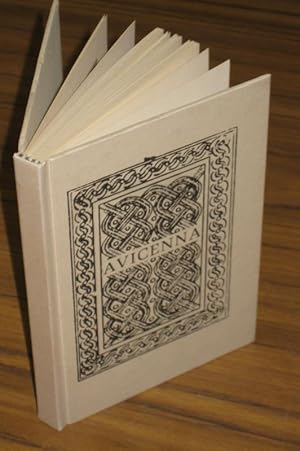
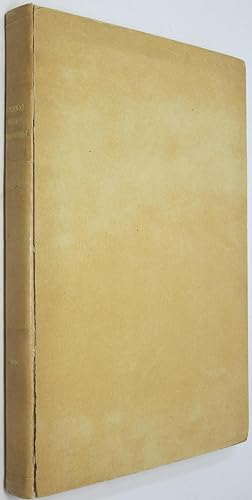
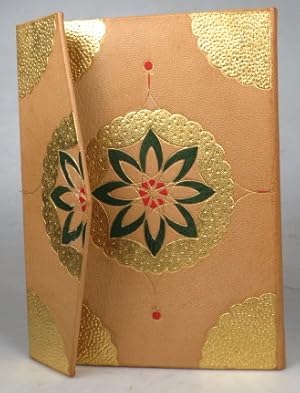
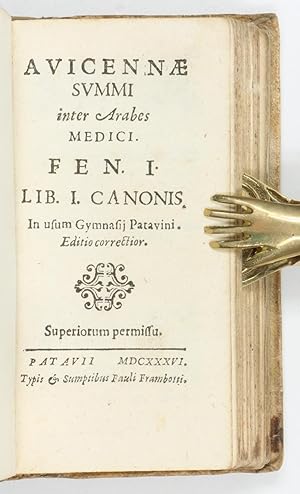
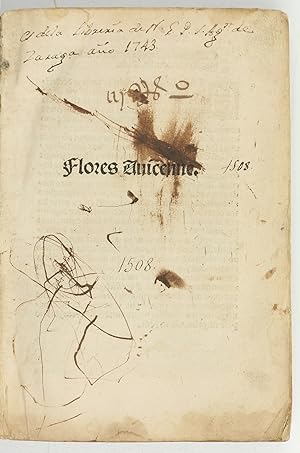
![Bild des Verkäufers für Al-Ilahiyat min al-Shifa' [The Metaphysics from the Book of Healing]. zum Verkauf von Antiquariat INLIBRIS Gilhofer Nfg. GmbH](https://pictures.abebooks.com/inventory/md/md31417291848.jpg)
![Bild des Verkäufers für Al-Urjuza fi l-tibb [Poem on Medicine] and other medical and alchemical treatises. zum Verkauf von Antiquariat INLIBRIS Gilhofer Nfg. GmbH](https://pictures.abebooks.com/inventory/md/md31098749344.jpg)
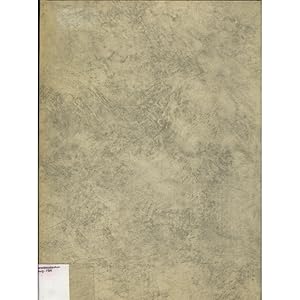
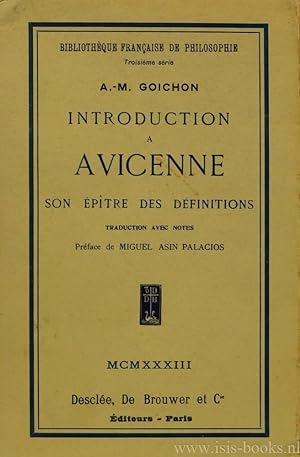
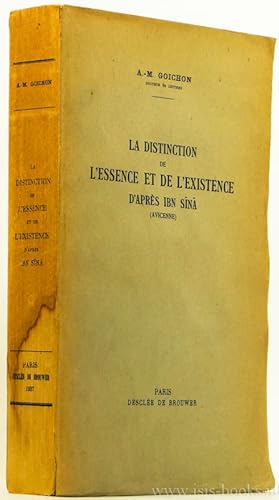
![Bild des Verkäufers für De febribus [.] in Avic[ennae] quarti canonis fen primam. Dilucida atque optima expositio [.]. zum Verkauf von Antiquariat INLIBRIS Gilhofer Nfg. GmbH](https://pictures.abebooks.com/inventory/md/md21857701086.jpg)
![Bild des Verkäufers für De febribus [.] in Avic[ennae] quarti canonis fen primam. Dilucida atque optima expositio [.]. zum Verkauf von Antiquariat INLIBRIS Gilhofer Nfg. GmbH](https://pictures.abebooks.com/inventory/md/md20025767724.jpg)


![Bild des Verkäufers für In primam totam Fen primi libri canonis Avicenn[a]e dilucidissima & expectatissima expositio. Nunc primum in lucem edita, illustrata, & completa aßiduo labore, & longo studio Marci Oddi Medici eiusdem filij. zum Verkauf von Antiquariat INLIBRIS Gilhofer Nfg. GmbH](https://pictures.abebooks.com/inventory/md/md30264260940.jpg)
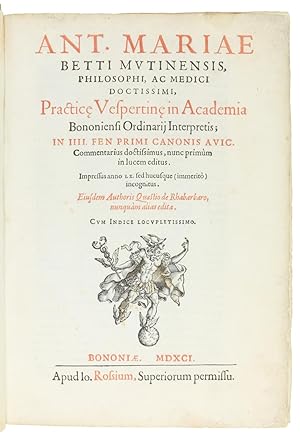
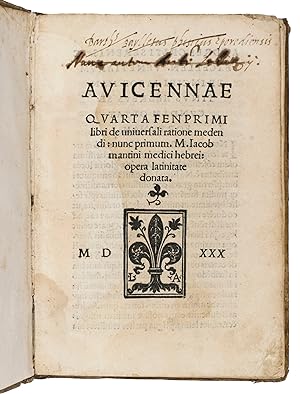
![Bild des Verkäufers für [Kitab al-Najah - French]. La logique du fils de Sina, communément appellé Avicenne, prince des philosophes et médecins Arabes. zum Verkauf von Antiquariat INLIBRIS Gilhofer Nfg. GmbH](https://pictures.abebooks.com/inventory/md/md31137210129.jpg)
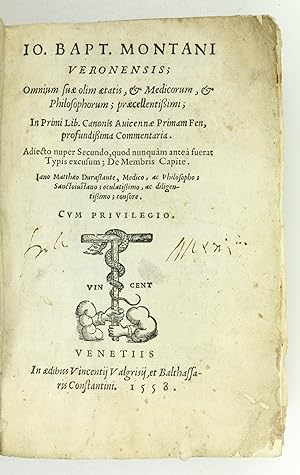
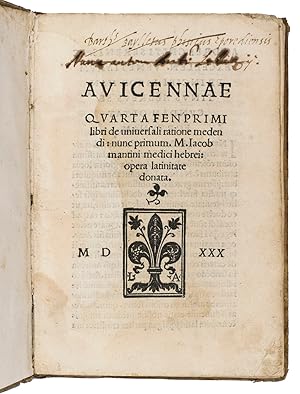
![Bild des Verkäufers für Canon medicinae, libri I-V. Translatus a magistro Gerardo Cremonensi. [With] De viribus cordis. Translatus ab Arnaldo de Villa Nova. zum Verkauf von Peter Harrington. ABA/ ILAB.](https://pictures.abebooks.com/inventory/md/md31663011390.jpg)
![Bild des Verkäufers für In primam totam fen primi libri canonis Avicenn[a]e dilucidissima & expectatissima expositio. Nunc primum in lucem edita, illustrata, & completa assiduo labore, & longo studio Marci Oddi medici eiusdem filii.Venice, Paolo and Antonio Meietti, 1575. 4to. With woodcut device on title-page, a woodcut headpiece, 3 large and 17 smaller woodcut decorated initials, and a small woodcut decoration (plus 1 repeat). Contemporary limp vellum, with manuscript title on spine. zum Verkauf von Antiquariaat FORUM BV](https://pictures.abebooks.com/inventory/md/md30296198704.jpg)
![Bild des Verkäufers für Al-Tuhfat al-Sa diya fi-t-tibb [Sa d s gift to medicine]. zum Verkauf von Antiquariat INLIBRIS Gilhofer Nfg. GmbH](https://pictures.abebooks.com/inventory/md/md31655843322.jpg)